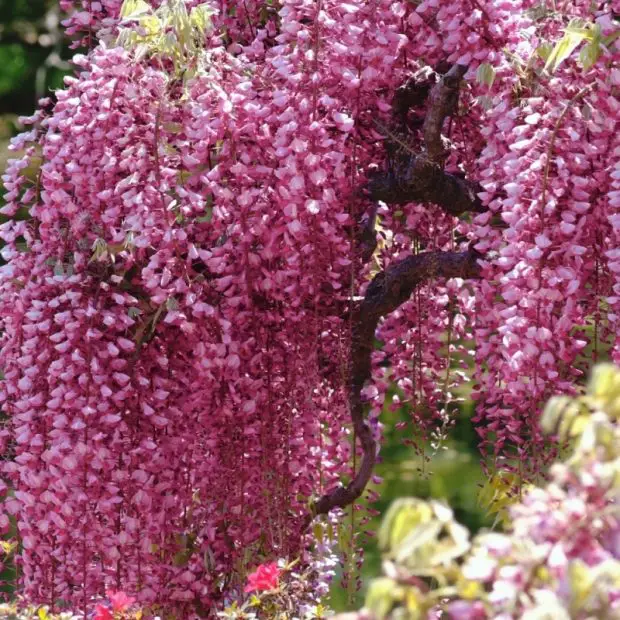Wisteria adds beauty, color, and charm to every garden it touches. Its hanging clusters of purple, blue, or white flowers create a soft, romantic view in spring. The vines grow quickly and wrap around fences, pergolas, and walls, bringing life to dull spaces. Many gardeners fall in love with its grace but feel frustrated when flowers don’t appear. When wisteria grows without care, it spends energy on leaves instead of blooms, leaving branches lush but colorless.
You can change that with consistent and proper care. Sunlight, pruning, and soil quality decide how well your wisteria blooms each season. A balanced routine builds stronger vines and richer clusters of flowers. This guide explains how to care for wisteria, from planting to yearly maintenance. With patience, you can enjoy its magical blooms every year and turn your garden into a scene of pure beauty.
Understanding Wisteria Plants

Wisteria is a strong, woody vine from the pea family that captures attention with its elegant beauty. It grows naturally in China, Japan, and parts of North America, climbing trees, fences, and old buildings. The vine can stretch over 30 feet and spread wide when it finds support. Its twisting stems wrap firmly around structures, creating a living sculpture. During spring, wisteria produces breathtaking clusters of flowers that hang down like purple or white curtains. Each bloom carries a sweet fragrance that fills gardens with charm and calm energy.
Wisteria thrives in bright sunlight and warm conditions. It needs six or more hours of full sun daily to bloom well. In shady locations, the plant focuses on green leaves instead of flowers. It grows best in rich, moist, and well-draining soil that supports strong root systems. Slightly acidic or neutral soil helps it absorb nutrients effectively. Once established, wisteria becomes a long-lived plant that grows stronger every year. Some vines can survive for more than a century, creating a timeless beauty that passes through generations of gardeners.
Because of its strength, wisteria needs space and proper support. Its stems twist tightly and can damage wooden posts if ignored. A solid metal trellis or stone wall provides stability and safety. Regular pruning keeps the vine under control and encourages fuller blooms. When trained correctly, wisteria turns into a spectacular centerpiece that attracts bees, butterflies, and hummingbirds. Understanding its natural habits allows you to guide its growth and enjoy vibrant blossoms year after year.
Choosing the Right Location for Wisteria
Wisteria grows best when it receives full sunlight and space to expand freely. The vine needs at least six hours of direct sun each day to bloom properly. Less light means fewer flowers and more leafy vines. A bright, open spot gives the plant the warmth and energy it needs to produce strong clusters of color. Morning sunlight also helps dry moisture on the leaves, keeping the plant healthy. The ideal places include open fences, pergolas, and stone or brick walls that can support its heavy vines. Strong structures keep wisteria safe and beautiful as it matures over time.
Soil quality matters just as much as sunlight. Wisteria thrives in deep, fertile soil that drains well but stays evenly moist. Standing water causes weak roots and stunted growth. Adding compost or organic mulch improves drainage and keeps nutrients available for the plant. Slightly acidic to neutral soil, around pH 6.0 to 7.0, supports strong roots and steady flowering. Once established, wisteria tolerates dry periods but still blooms best with consistent watering. Rich soil and balanced moisture create the perfect foundation for healthy, long-lasting growth.
The right location also means thinking ahead about space and structure. Wisteria grows large and can live for decades if maintained well. Give it plenty of room, at least 10 feet from other trees or shrubs. Its vines grow fast and can overwhelm nearby plants if planted too close. Choose a location that allows airflow and sunlight from all sides. When placed wisely, wisteria becomes a garden treasure, filling every spring with color, fragrance, and natural elegance.
Planting Wisteria Correctly
Planting wisteria correctly helps the vine grow strong and bloom for many years. Choose a sunny, open space where the plant can climb freely. The best time to plant is early spring or early fall when the soil stays cool and moist. Dig a hole twice as wide as the root ball and about the same depth. Keep the top of the roots level with the ground surface. Place the vine in the center and fill the hole with rich, loose soil. Press the soil gently around the roots to remove air pockets. Water deeply after planting to help the roots settle.
Healthy soil creates the best start for wisteria. The plant prefers fertile, well-draining soil with plenty of organic matter. Add compost, leaf mold, or aged manure to improve texture and nutrient levels. If your garden soil is heavy clay, mix in sand or perlite for better drainage. Avoid using too much fertilizer, especially high-nitrogen blends, because they promote leaf growth instead of flowers. Keep the soil evenly moist during the first year while roots grow. A layer of mulch around the base helps hold moisture, reduce weeds, and protect roots from heat.
Strong support ensures the vine grows safely and beautifully. Install a metal trellis, wooden arbor, or wire frame before planting. Wisteria climbs by twining its stems, so give it something sturdy to grip. As it grows, train young shoots in the right direction and tie them loosely with soft twine. Check the ties often to prevent girdling as the stems thicken. Early training helps form a balanced, graceful shape and prevents tangled vines later. With the right planting method, your wisteria will flourish for decades and reward you with abundant blooms.
Watering and Soil Care for Healthy Growth
Watering Wisteria the Right Way
Proper watering helps wisteria stay strong and produce more blooms each year. The vine loves deep, steady moisture but dislikes soggy soil. During its first two years, give the plant a slow soak once or twice weekly. Deep watering encourages the roots to reach downward and become sturdy. In hot, dry months, increase watering to prevent leaf wilt and flower loss. Mature vines can survive short droughts, but they need regular watering when buds form. Use a gentle spray or drip system to moisten the soil evenly and avoid runoff. Always water at the base instead of wetting the leaves.
Morning watering works best because it keeps leaves dry through the day and prevents fungal growth. Add a two-inch layer of mulch to conserve moisture and cool the roots. Organic mulch such as bark or straw slowly releases nutrients as it breaks down. Check soil moisture by inserting your finger two inches deep; if it feels dry, it’s time to water. Avoid constant wetness because it weakens roots and reduces blooms. Balanced watering creates strong vines, resilient foliage, and full, fragrant flower clusters each spring.
Maintaining Ideal Soil Conditions
Healthy soil keeps wisteria vigorous, balanced, and ready to bloom every season. The vine thrives in slightly acidic to neutral soil, between pH 6.0 and 7.0. Before planting, mix compost, peat moss, or aged manure into the ground to improve texture and nutrition. Well-draining soil allows oxygen to reach the roots and prevents disease. If your soil holds too much water, mix in sand or perlite for better airflow. Each spring, refresh the top layer with organic matter to maintain fertility and promote microbial life.
Avoid chemical fertilizers that contain high nitrogen, as they push leafy growth instead of blooms. A slow-release fertilizer with balanced nutrients once a year is enough. Renew mulch regularly to lock in moisture and stabilize temperature. Keep mulch a few inches away from the stem to prevent rot and pest buildup. Loosen compacted soil gently with a fork to improve air circulation. When you maintain healthy, nutrient-rich soil, your wisteria grows stronger, roots deepen, and blossoms multiply beautifully each spring.
Pruning Wisteria for Maximum Blooms
Pruning wisteria is the key to keeping it healthy, compact, and full of blossoms. The vine grows quickly and sends out long shoots that can overwhelm nearby structures. Without regular pruning, it produces more leaves and fewer flowers. The best time for the first pruning is in late winter or early spring before new growth starts. At this stage, cut back the long shoots from last year to two or three buds. This method directs the plant’s energy toward flower production instead of leafy growth. Early pruning also shapes the vine and keeps it easy to manage.
Summer pruning encourages stronger flower buds for the next year. Around mid to late summer, shorten new shoots to about six inches long. This step improves air circulation and sunlight exposure, both of which help the plant form buds. Removing weak, tangled, or crowded stems also prevents disease and pest buildup. Always use clean, sharp tools to make smooth cuts. You can train the remaining shoots along trellises or wires to form neat patterns. Consistent summer pruning keeps wisteria balanced and full of potential for vibrant spring blooms.
Regular pruning not only improves flowering but also protects structures from damage. Old, thick stems can become heavy, especially after rain. Removing excess wood reduces weight and allows more energy for new growth. If the plant grows too dense, thin the inner branches to open up the center. This approach lets light and air reach every part of the vine. With patient pruning and steady care, your wisteria rewards you with abundant flowers that return every year in breathtaking beauty.
Supporting and Training Wisteria Vines
Wisteria grows with strength and determination, so proper support is essential from the start. The vine can reach more than 30 feet in length and becomes heavy with time. Without a strong structure, it can twist or break under its own weight. The best supports include metal trellises, wooden arbors, sturdy pergolas, or thick wires fixed along walls. Always choose durable materials that can handle the plant’s pressure and age well outdoors. Install supports before planting so the roots can grow undisturbed. Once established, the vine wraps tightly around whatever it touches, forming beautiful natural curves.
Training the vine early shapes its growth and prevents tangling. When young, wisteria needs guidance to climb in the right direction. Select one or two main stems as leaders and tie them gently with soft garden twine. As the plant grows, continue tying new shoots to maintain an even shape. Check the ties regularly and loosen them when the stems thicken. This process prevents girdling and allows the vine to grow freely. By encouraging upward growth first, you help the plant create a strong framework for future flowering branches.
As wisteria matures, it benefits from occasional adjustments. Remove side shoots that grow in awkward directions or interfere with structures. Keep the main stems clear and trained along the support. When managed carefully, the vine forms elegant arches and cascades of flowers that hang gracefully each spring. The combination of strong support and gentle training allows wisteria to thrive safely for decades. A well-guided vine turns any garden into a scene of living art filled with color and fragrance.
Feeding and Fertilizing Wisteria
Feeding wisteria correctly helps the vine stay strong and bloom consistently each year. While wisteria is hardy, it still needs balanced nutrition to maintain energy for flowering. Young vines benefit from light feeding during the first growing season. Mix compost or aged manure into the soil once in early spring. This organic matter releases nutrients slowly and improves soil texture. Mature plants often need less feeding because their deep roots gather minerals from the soil. However, after heavy flowering or pruning, a small nutritional boost helps them recover and prepare for the next bloom cycle.
The right fertilizer makes a big difference in how wisteria grows and blooms. Avoid high-nitrogen fertilizers because they encourage leaf growth instead of flowers. Use a balanced or low-nitrogen blend, such as 5-10-10, once in early spring before buds appear. Apply it around the root zone and water well afterward. This feeding strengthens flower buds and helps produce brighter, longer clusters. Mid-summer feeding can also help if the plant looks weak or the soil is poor. Always follow with deep watering to move nutrients down to the roots where they’re most effective.
Natural feeding methods work best for long-term growth. Compost tea, seaweed extract, or fish emulsion gives the vine trace minerals that enhance bloom quality. A yearly layer of organic mulch adds slow-release nutrients and protects the soil. Avoid overfeeding since excess nutrients make the vine grow aggressively without flowering. Balanced, moderate feeding creates a steady rhythm of growth and bloom. When wisteria receives the right nutrition, it rewards your care with lush leaves, strong stems, and spectacular flowers year after year.
Essential Steps to Care for Wisteria
Caring for wisteria means providing structure, sunlight, and regular attention throughout the year. This vine thrives under warm, bright conditions and needs at least six hours of full sunlight daily. Without enough light, flowers become sparse, and the plant focuses on leaf growth. Keep the soil evenly moist, especially during dry or hot weather. Deep watering once or twice a week helps roots grow deep and strong. Avoid shallow watering, which keeps roots near the surface and weakens the vine over time. When light, temperature, and water balance well, wisteria rewards you with vigorous growth and stunning blooms.
Pruning and feeding play a major role in yearly maintenance. Prune wisteria twice a year—once in late winter and again in midsummer. Remove long, tangled shoots to shape the vine and encourage new flower buds. After pruning, apply compost or a low-nitrogen fertilizer to restore nutrients. Fertilizing in spring helps produce healthy shoots and stronger blooms later. Spread organic mulch around the base to hold moisture, suppress weeds, and protect roots. Regular care keeps the plant balanced, reducing stress and boosting flower production season after season.
Training and support complete the process of wisteria care. Guide new stems along wires, trellises, or arbors to form an even, strong frame. Tie stems loosely with soft cloth or garden twine so they can expand freely. Check and adjust ties each month as vines grow thicker. Remove weak or crowded branches to let air and sunlight reach inner parts of the plant. Strong training and steady monitoring help wisteria stay healthy, structured, and full of color each spring.
Encouraging Wisteria to Bloom Every Year
Encouraging wisteria to bloom every year requires patience, timing, and understanding the plant’s rhythm. Young vines often take several years to flower, but proper care speeds the process. Sunlight plays the most important role in blooming success. Choose a bright, open location with at least six hours of sunlight daily. Shade delays flowering and weakens buds. Keep the soil moist but not soggy, especially during the growing season. Add compost in early spring to refresh nutrients and improve soil texture. A healthy foundation ensures strong buds and full flower clusters each year.
Pruning remains the secret to reliable blooming. In late winter, shorten the long shoots from last season to two or three buds. This trimming redirects energy from vine growth to flower production. During midsummer, prune again and reduce new shoots to about six inches. This helps sunlight reach the inner branches and strengthens flower spurs for next spring. Always remove dead, crowded, or weak stems that consume nutrients. Clean tools prevent disease and keep cuts smooth. With steady pruning, the vine develops a cycle of balanced growth and yearly blooms.
When wisteria still refuses to flower, a few adjustments can help. Reduce watering slightly in late summer to signal rest before winter. Avoid high-nitrogen fertilizers, which create leafy growth instead of blossoms. A fertilizer high in phosphorus or potassium encourages more buds. You can also gently stress the roots by pruning the tips or digging around them to trigger flowering. Keep the soil warm, well-drained, and free of weeds. Over time, your vine learns to bloom faithfully every year, covering the garden in cascading color and soft fragrance.
Seasonal Care Tips for Wisteria
Spring Care
Spring brings life back to wisteria after its winter rest. As buds swell and shoots appear, start by removing weeds, old mulch, and dead leaves around the base. Refresh the soil with compost or aged manure to provide natural nutrients. A light feeding with low-nitrogen fertilizer supports blooming without pushing excess foliage. Water deeply once a week, allowing the soil to stay moist but never waterlogged. The roots need steady hydration to build energy for flower production. Ensure your wisteria gets at least six hours of sun daily to achieve vibrant colors.
After flowering, prune faded clusters to prevent seed formation and redirect energy toward new growth. Tie soft new shoots to the support structure, guiding their direction for even coverage. Watch for early signs of pests such as aphids or scale insects, which can damage young leaves. Remove them manually or spray with insecticidal soap if necessary. Reapply a thin mulch layer to preserve soil moisture and reduce temperature swings. Consistent spring care strengthens the vine’s foundation, leading to lush growth and heavy blooms each year.
Summer Care
Summer heat demands extra attention to watering and pruning. Wisteria grows fast during this period and can tangle easily if ignored. Water deeply once or twice a week, depending on temperature and rainfall. Early morning watering prevents leaf burn and fungal problems. Use mulch to lock in moisture and cool the soil. Avoid watering leaves directly to prevent mildew. Regularly check the vines for pests such as spider mites and caterpillars, which appear in warm, dry conditions. Quick removal protects new shoots and keeps foliage bright green.
Pruning in midsummer maintains balance and promotes future blooms. Shorten new growth to about six inches to help sunlight reach lower branches. This encourages strong buds for the next spring. Remove faded flowers and yellowing leaves to keep the vine healthy and clean. Add a small amount of phosphorus-rich fertilizer if the soil seems poor. Check trellises and arbors for stability since heavy vines can strain structures in strong winds. With steady watering, light feeding, and timely pruning, summer care keeps your wisteria lively, green, and full of energy.
Fall Care
Fall signals the time to prepare wisteria for dormancy. As growth slows, reduce watering to let the plant toughen before winter. Clear fallen leaves, old mulch, and dead stems from the base to prevent mold or fungal buildup. Cut back weak, diseased, or crossing branches to improve airflow. Avoid fertilizing in autumn because new growth may freeze in cold weather. Instead, focus on cleaning, shaping, and strengthening the plant’s frame. Check the soil’s drainage, since heavy rain in fall can cause root stress. Healthy roots are key for a strong spring comeback.
Add a layer of organic mulch, such as bark chips or straw, to protect roots from temperature changes. Lightly loosen the topsoil to maintain oxygen flow. Inspect your trellis or pergola and fix any damage before winter storms arrive. Tie young shoots gently to prevent snapping in strong winds. In colder climates, cover the base with extra mulch or burlap for insulation. Fall care may seem simple, but these steps help your wisteria rest safely and wake up vigorous, ready to bloom again in spring.
Winter Care
Winter offers wisteria a quiet season to rest and rebuild its strength. Even in dormancy, a little care makes a big difference. Check the vine after heavy winds or snow to ensure supports remain solid. Remove broken or tangled stems to keep the shape tidy. Water lightly during dry spells if the soil feels dry, especially in mild climates. Protect the root zone with a thick mulch layer to prevent freezing and moisture loss. In extremely cold areas, wrap the base with burlap to shield it from harsh frost.
Late winter is the perfect time for structural pruning. Trim back side shoots to two or three buds to prepare for new flower growth. Cut out old or weak branches to let light and air reach the plant’s center. Clean your pruning tools before and after use to avoid spreading disease. Inspect for damage and repair trellises or arbors before spring. By maintaining the vine through winter, you set the stage for vigorous shoots and rich blooms in the coming year. Calm, steady winter care leads to breathtaking spring displays.
Common Problems and How to Fix Them
Yellow Leaves and Poor Growth
Yellow leaves signal that wisteria faces stress from watering, soil, or nutrient imbalance. Too much water reduces oxygen and weakens roots. Always test the soil before watering. If it stays soggy, loosen the top layer to improve airflow. Add organic matter like compost or sand to increase drainage. Wisteria prefers moist but not waterlogged soil. Insufficient sunlight also causes fading leaves and weak vines. Trim nearby branches or objects that block light. Six or more hours of daily sun restore healthy color and strength. Regular sunlight also helps the vine resist disease and grow evenly.
Nutrient imbalance often turns leaves yellow while veins stay green. This problem points to iron or magnesium deficiency. Add compost, worm castings, or a mineral-rich fertilizer to correct it. If your soil is too alkaline, mix in peat moss or sulfur to lower the pH. Avoid overfeeding with nitrogen-heavy fertilizer, as it encourages leaves instead of blooms. Check for pests like aphids or spider mites that drain sap and cause yellowing. Once you balance nutrients, water, and light, new leaves appear vibrant, and the vine grows vigorously again.
Wisteria That Refuses to Bloom
A lush, healthy wisteria that refuses to bloom usually needs adjustments in care. Excess nitrogen remains the most common cause. Nitrogen pushes green growth but suppresses flowering. Switch to a low-nitrogen, phosphorus-rich fertilizer to encourage buds. Apply it in early spring and water well afterward. Pruning also matters greatly for flowering. Cut long shoots in winter to two or three buds. Shorten new growth in midsummer to six inches. These cuts help the plant focus energy on flower spurs instead of leaves. Consistent trimming each year builds a steady rhythm of bloom cycles.
Age and light conditions also affect flowering. Young vines often need three to five years to mature. Give them time and strong sunlight to trigger bud formation. At least six hours of direct sun daily ensures abundant flowers. To encourage older plants, lightly stress the roots in late summer by cutting around the root zone with a spade. This signals the plant to produce blooms next season. Avoid moving mature vines, as wisteria dislikes disturbance. With sunlight, pruning, and patient care, your vine will eventually reward you with breathtaking cascades of flowers each spring.
FAQs About Caring for Wisteria
How long does it take for wisteria to bloom after planting?
Wisteria usually needs three to five years to bloom after planting. Some grafted varieties flower sooner because their roots mature faster. Give your vine full sunlight, rich but well-drained soil, and patient pruning. Once established, it will reward you with cascading blooms every spring.
Why is my wisteria growing leaves but not flowers?
Wisteria often grows leaves instead of flowers due to excess nitrogen or poor sunlight. Use a phosphorus-rich fertilizer to stimulate blooming and reduce nitrogen-based feeds. Prune regularly to redirect energy into buds. Ensure six or more hours of sunlight daily for strong and colorful flowers.
Can wisteria grow in pots or containers?
Yes, wisteria can grow beautifully in large pots with proper care. Use a container at least 20 inches wide with strong support for climbing. Choose compact or grafted varieties. Water deeply, prune often, and feed lightly each spring to keep the plant healthy and flowering.
When should I prune wisteria for the best results?
The best time to prune wisteria is twice a year—once in late winter and again in midsummer. Cut long stems back to two or three buds in winter and trim new shoots to six inches in summer. This method controls growth and encourages abundant flower clusters each season.
Does wisteria need fertilizer every year?
Wisteria grows best in fertile soil but doesn’t need heavy feeding every year. Apply compost or a balanced low-nitrogen fertilizer in spring. Avoid overfertilizing since too much nitrogen promotes leaf growth instead of blooms. Healthy, nutrient-rich soil naturally supports regular, vibrant flowering cycles.
Conclusion
Caring for wisteria takes patience, timing, and steady dedication, but the results are truly breathtaking. With proper pruning, rich soil, and full sunlight, this graceful vine transforms gardens into colorful masterpieces. Each season brings new life, cascading flowers, and a sweet fragrance that fills the air. Wisteria rewards consistent care with stronger vines and brighter blooms every year. Over time, it becomes a symbol of balance, growth, and beauty that lasts for decades. When you nurture wisteria with care and attention, it returns that love through endless blossoms each spring.






